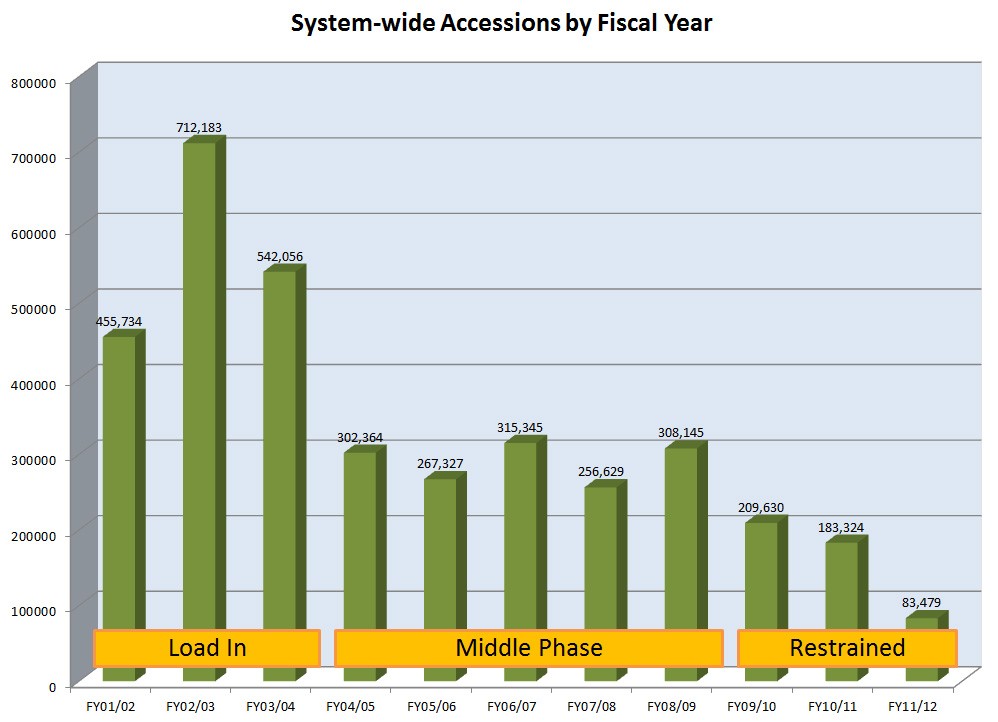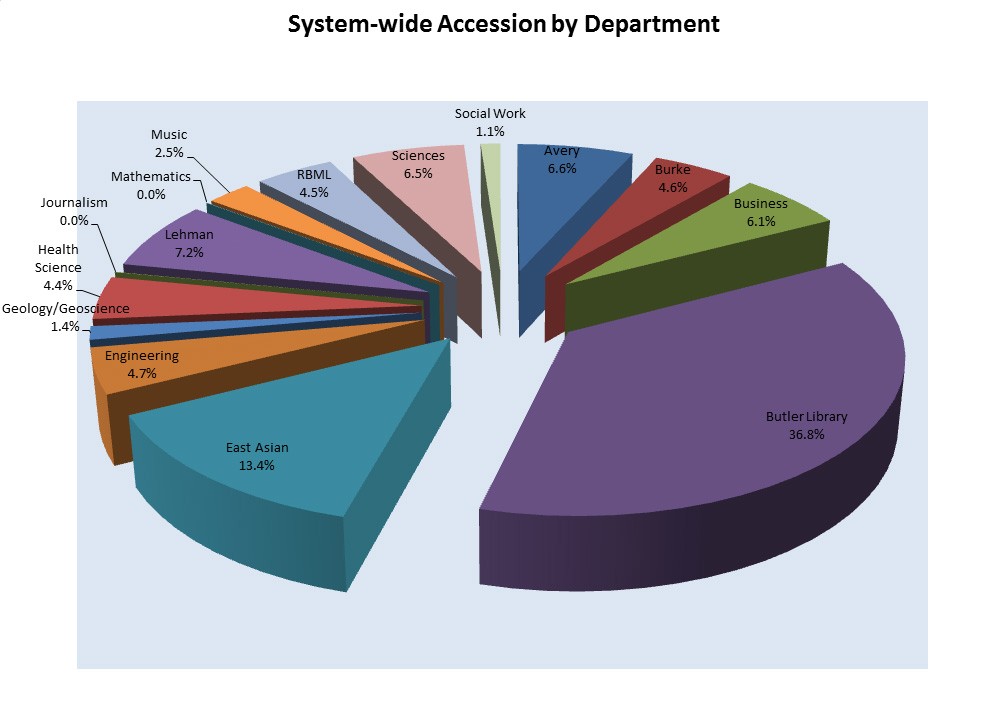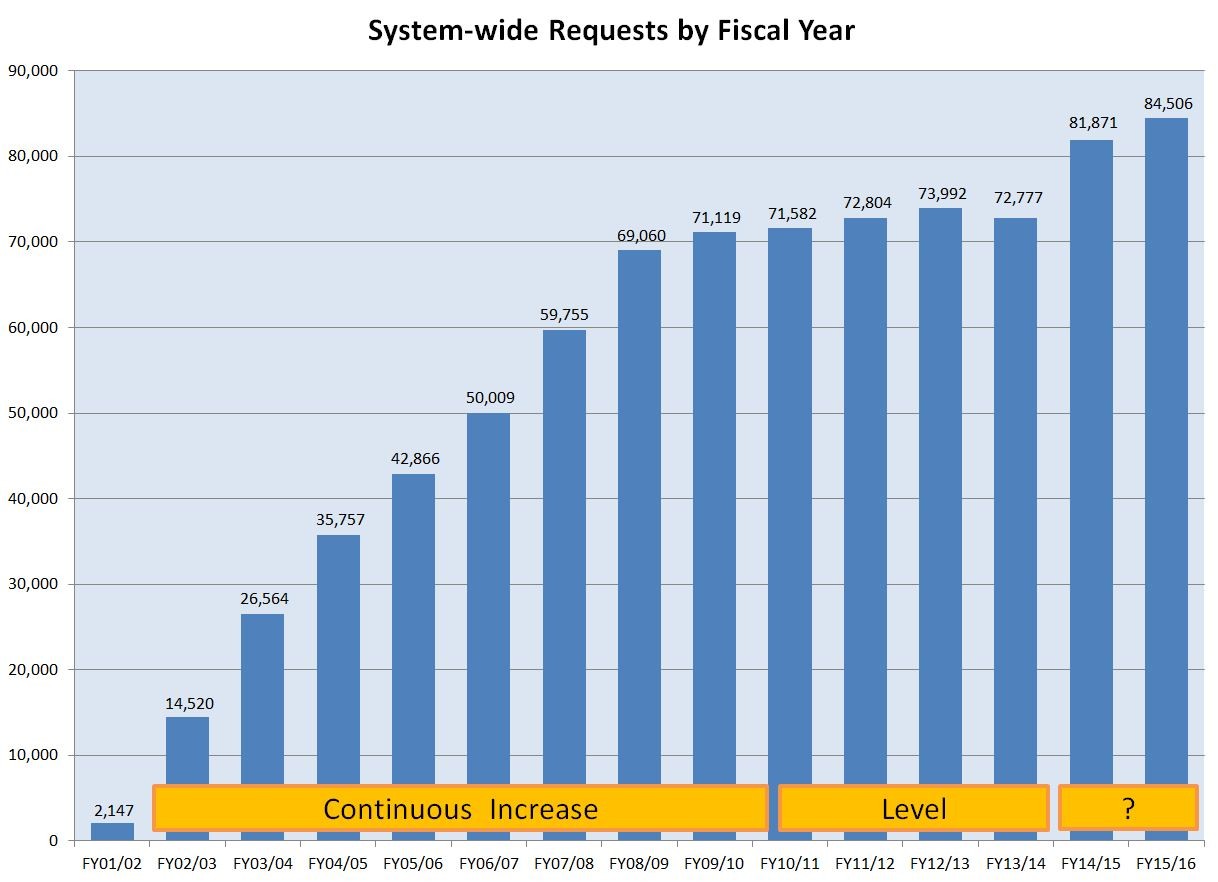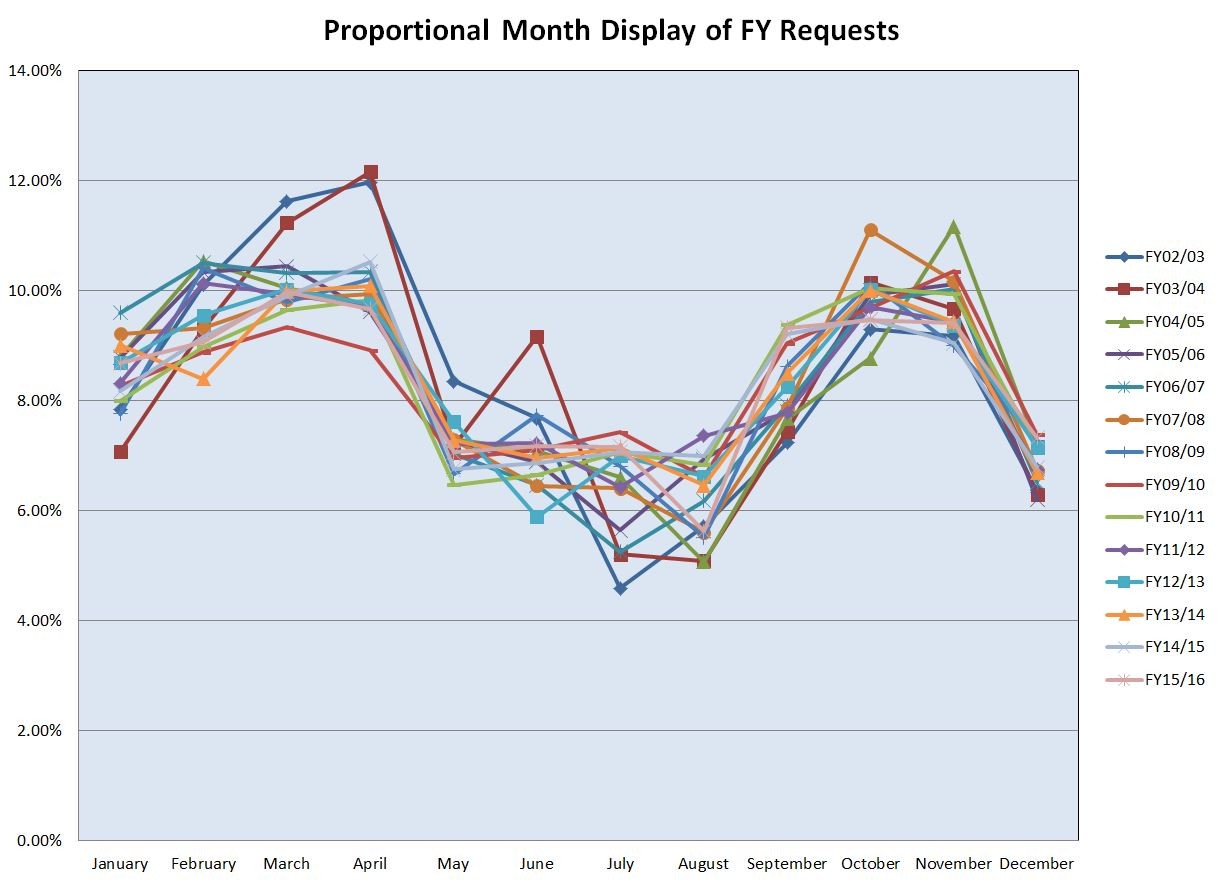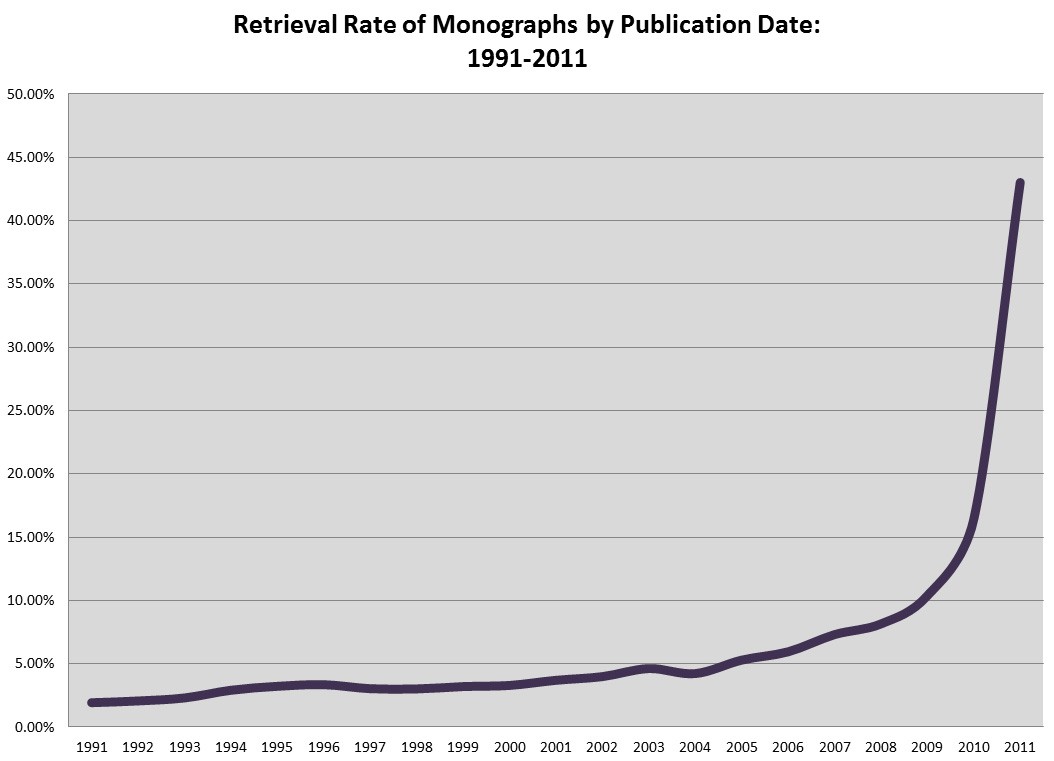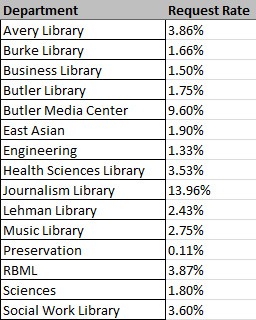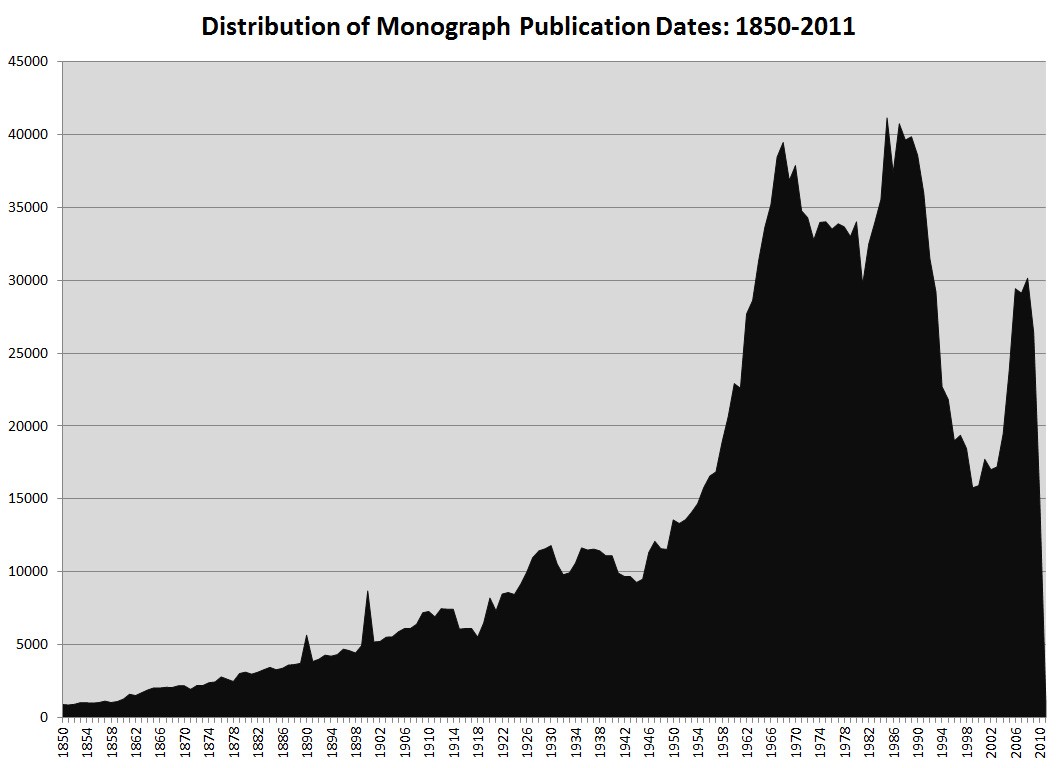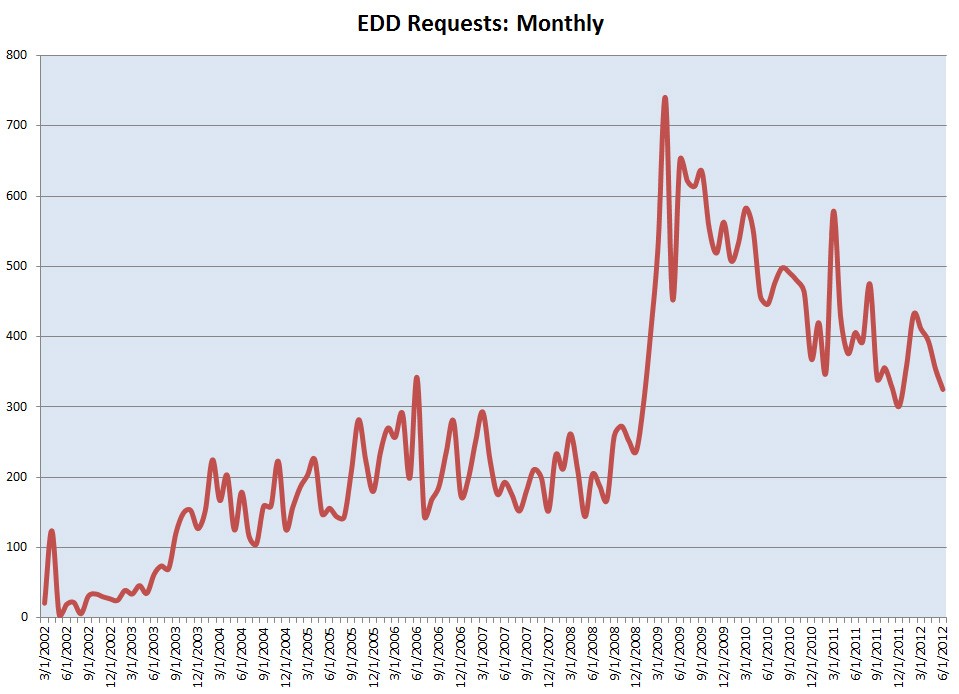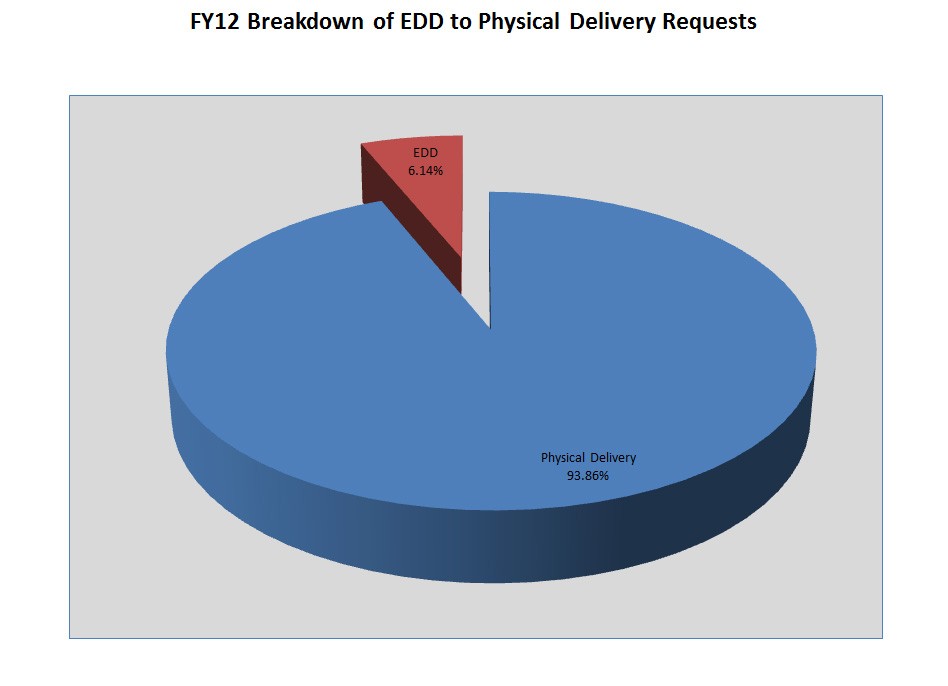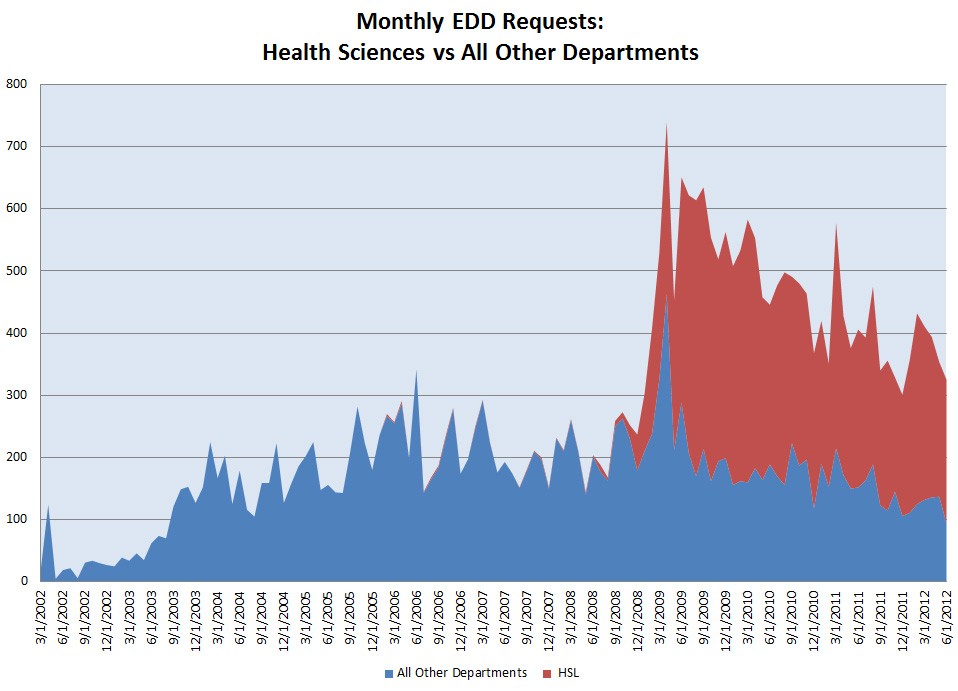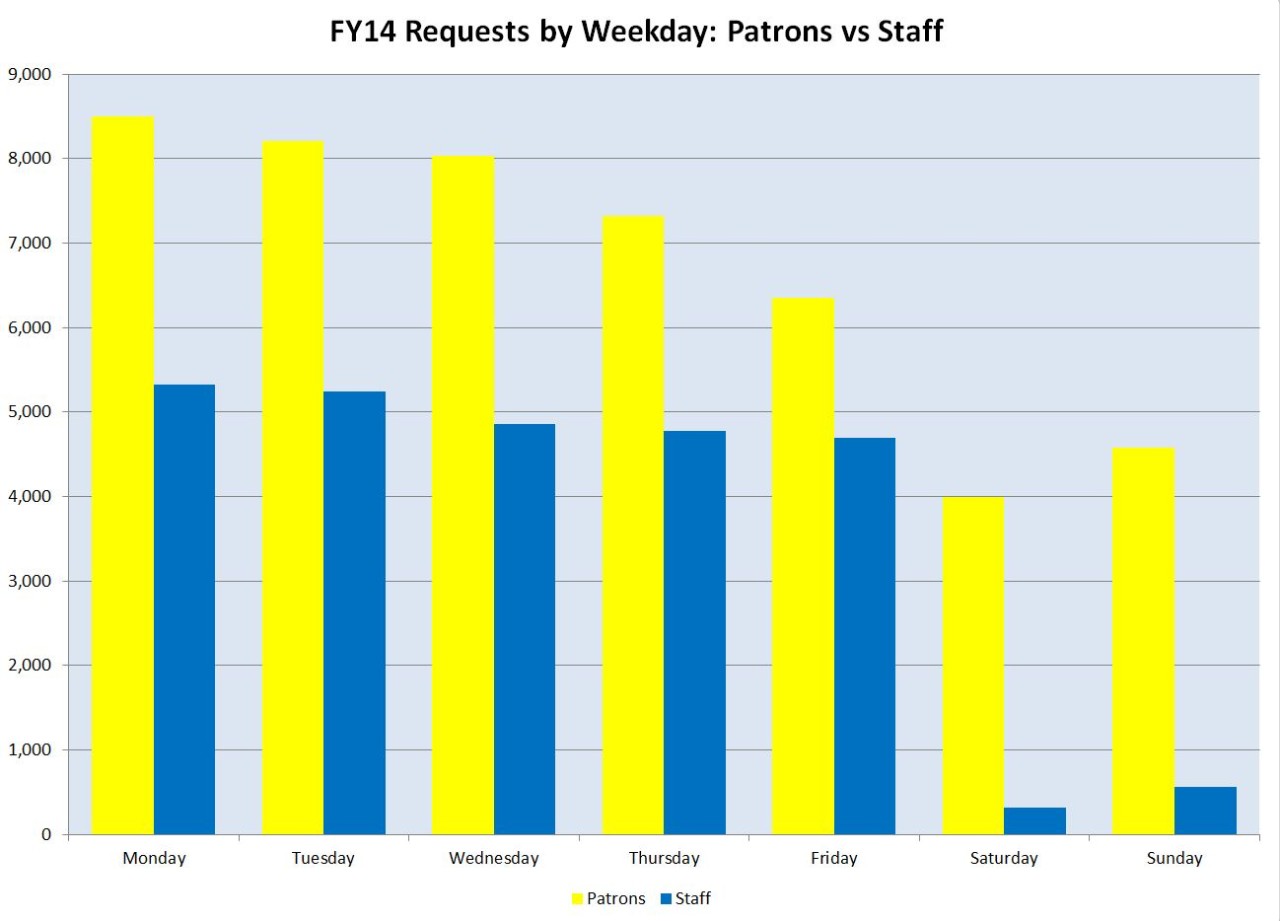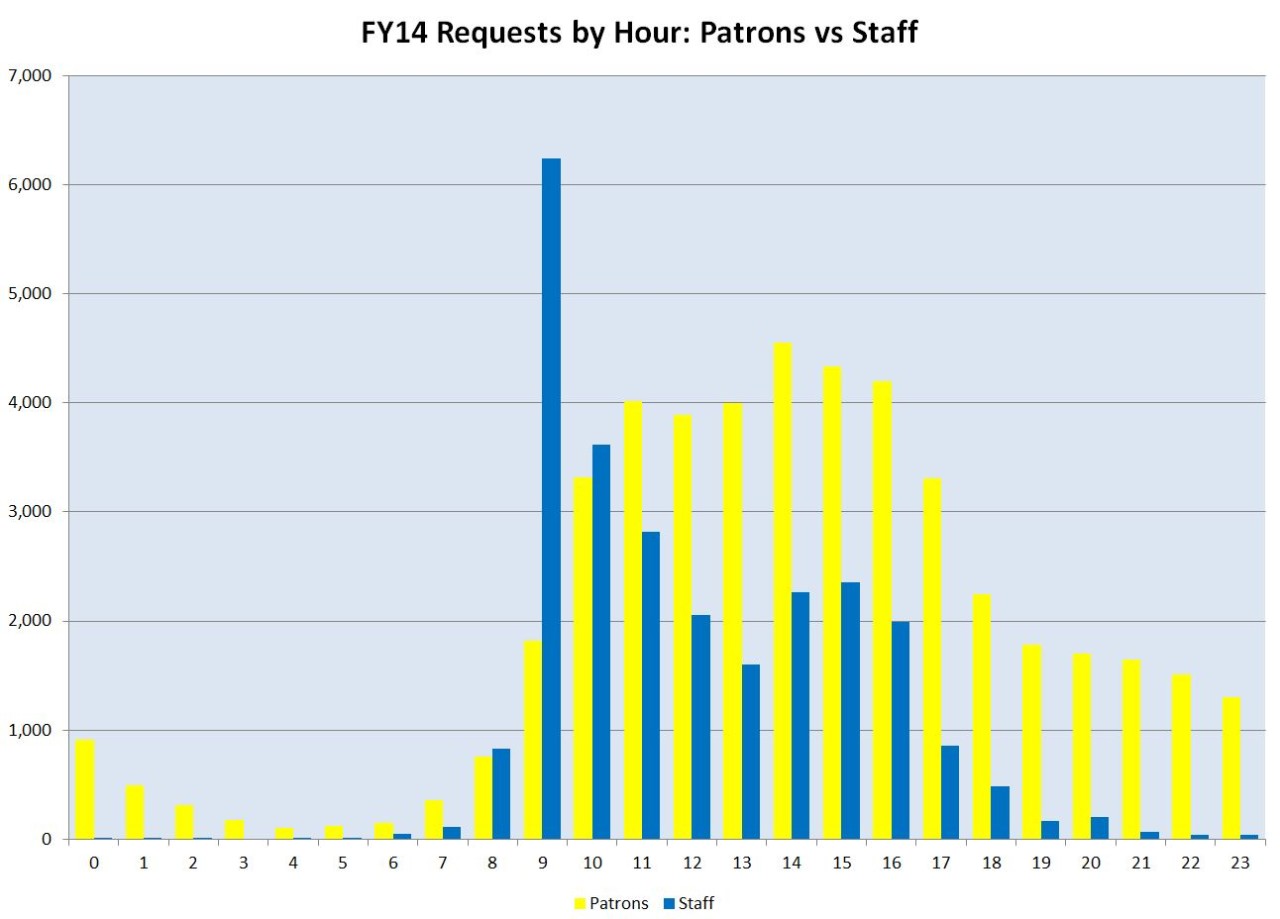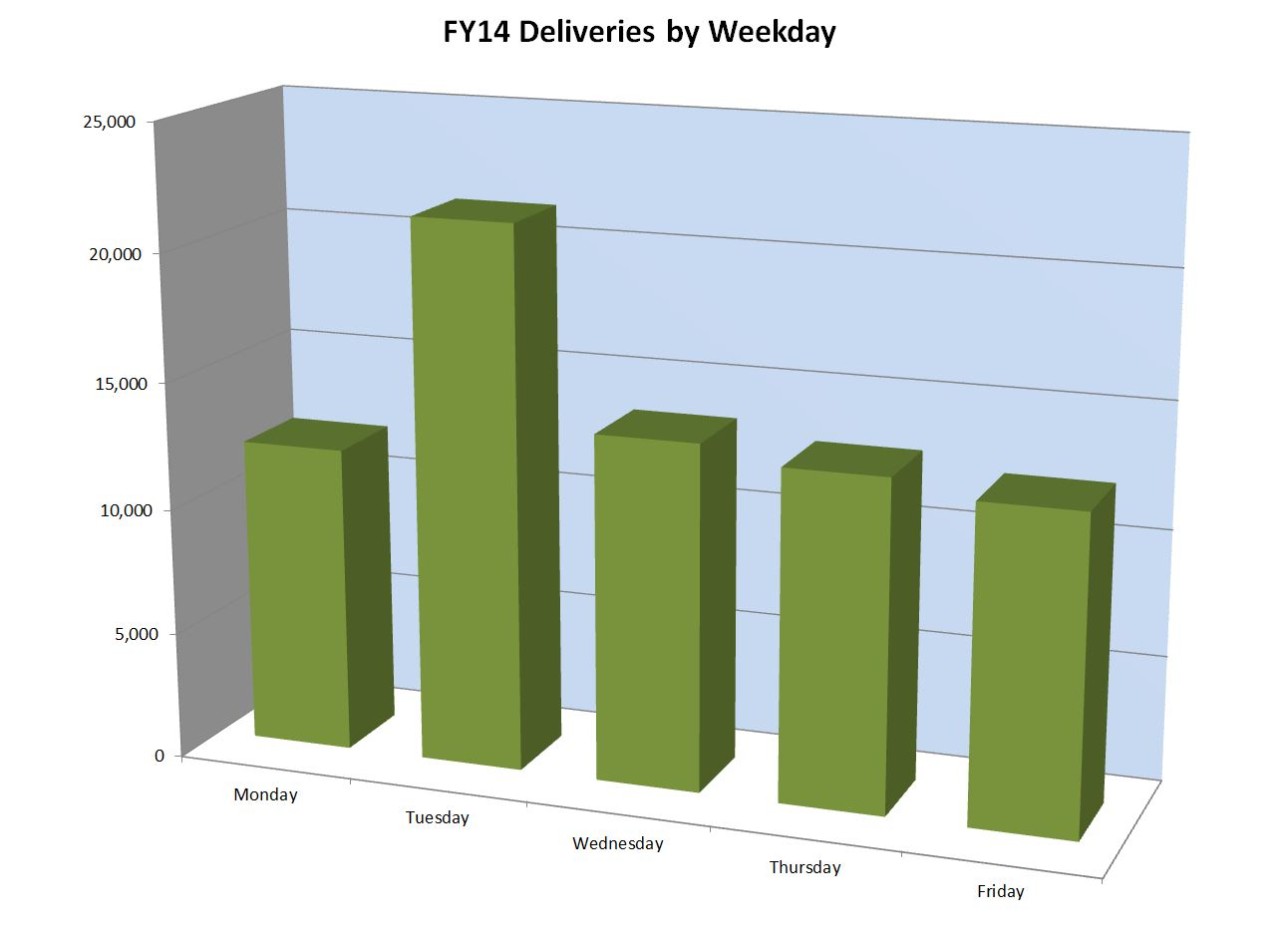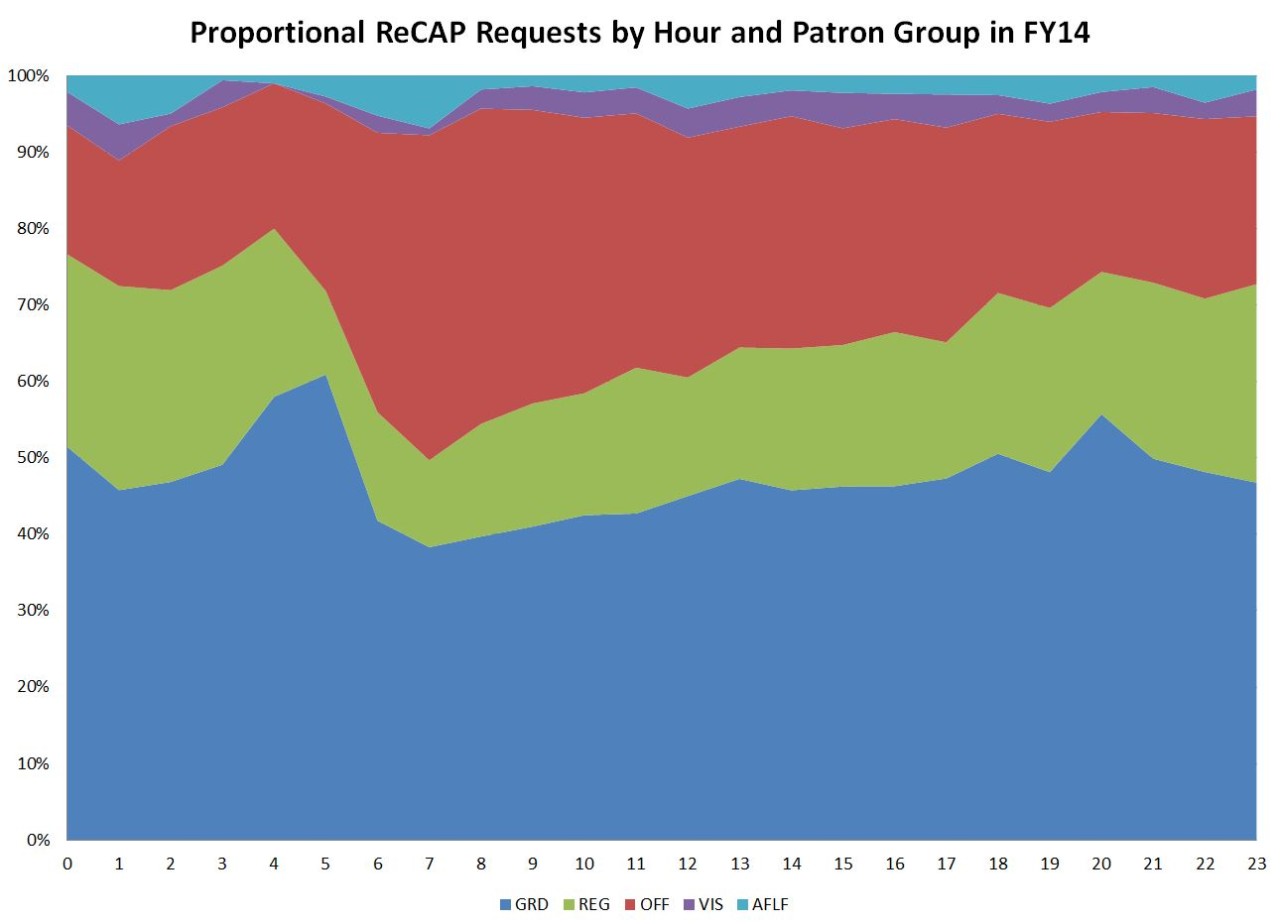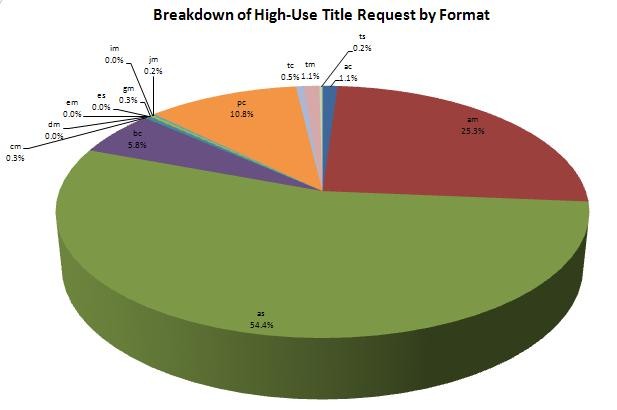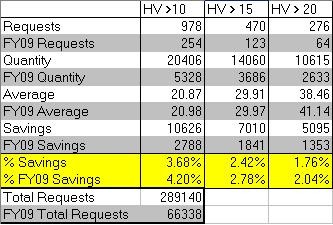Delivery Services Data Center
The Delivery Services Data Center website collects, defines and analyzes data related to Columbia University Library collections and services overseen by the Delivery Services unit in 307 Butler Library.
Raw data are collected at varying intervals and archived. Analysis is posted separately. For more information on individual categories please see executive summaries listed under headings.
Main Categories
Presentations
- Part 1: Accession
- Part 2: Request (.pptx)
- Part 4: EDD
- Part 5: Request Rate
- Part 6: High-Use Titles
Analysis
- Request rate
- Timing of Requests
- High use titles
- High volume requests
- EDD (Electronic Document Delivery)
- Publication Date (Monographs)
- Customer Code Correspondence
Special Projects
Accession
An item is accessioned when it is processed by ReCAP staff and shelved at the facility. To be accessioned a book must have a unique barcode and be in good condition. Accession data is tracked by both ReCAP and CUL. Each institution tracks different elements associated with barcodes, see categories below. Together they provide an accurate record of CUL collections at ReCAP and a powerful tool for analysis.
- Accession Executive Summary : Summary of data sources and validity
1. ReCAP Accession Data
ReCAP maintains a database (LAS) of all processed barcodes, including those of items permanently withdrawn. This database is separate from CUL’s CLIO database. ReCAP reports monthly accessions on a statistics website. ReCAP collects data for all consortium partners. CUL Law Library is tallied separately because of different ILS and request system.
- Raw accession data : Compiled by ReCAP per month
- Categories: Date, Consortium Partner, Customer Code, Accession, Retrieved, Out on Return and Permanent Withdrawal
2. CUL Accession Data
CUL designates off-site collections with CLIO location format off,xxx. CUL retrieves weekly batch files of new accessions from ReCAP. Using batch files CUL staff update CLIO location and request button in the OPAC. Granular data about each item is available via Voyager.
- Raw accession data : Compiled by CUL per month
- Categories: Barcode, Customer Code, Accession Date, Bib ID, Format, Publishing Date, Language, Title, Holdings ID, Call Number, Enumeration/Chronology, Item ID, CLIO Location, Call Number Subject1, Call Number Subject2, Year of Accession, Month of Accession, Day of Accession, and Fiscal Year
Data & Presentations
- ReCAP Data, Part 1: Accession : Summary of accession data available from CUL, includes charts and analysis.
Related Documentation
- Outline of ReCAP Accession : Simplified model of the process of accession at ReCAP
- Request Button in CLIO : How and when the Offsite request button appears in the OPAC
- LAS : Introduction to ReCAP Database (LAS)
- ReCAP-related Reports : Includes weekly Accession Reports used by staff to resolve irregularities
- New Acquisitions for ReCAP : How new acquisitions are routed directly to ReCAP
Request (Retrieval)
Executive Summary (.docx): Summary of data sources, validity and definition of terms. See Data and Presentations section below for more in depth analysis and charts.
The terms request and retrieval are used interchangeably in most ReCAP documentation. There is an important difference between the two: CUL tracks requests, ReCAP tracks retrievals. There is not a one-to-one correspondence between requests and retrievals. An item may be retrieved without a request on record in CUL systems. Likewise, a request may go unfilled without a retrieval, for example in the case of request failure.
An item is retrieved when ReCAP staff has taken it from the shelf for delivery. Most requests are submitted via CLIO and tracked by both CUL and ReCAP. Some retrieval requests circumvent CUL's mechanisms and are only tracked by ReCAP (e.g. Google scanning project). ReCAP reports monthly retrievals on a statistics website. ReCAP tracks data for all consortium partners. CUL Law Library is tallied separately because of different LMS.
1. ReCAP Retrieval Data
Tracks all retrievals by customer code. Retrieval data is subset of accession data.
- Full data set available upon request
- Categories: Date, Consortium Partner, Customer Code, Retrieved
2. CUL Request Data
CUL maintains archive files of requests placed via CLIO request mechanisms. Request totals are tracked by fiscal year that runs from July to June. This set is supplemented by granular data in Voyager.
- Full data set available upon request (.xlsx)
- Categories: Barcode, Delivery Location, Default Delivery Location, Date, Time, Type, Patron Group, Bib ID, Format, Publishing Date, Language, Title, Holdings ID, Call Number, Enumeration/Chronology, Item ID, CLIO Location, UNI, Hashed UNI, Year of Request, Month of Request, Day of Request, Hour of Request, Minute of Request, and Fiscal Year
Data & Presentations
- ReCAP Data, Part 2: Request (.pptx) : Summary of request data available from CUL, includes charts and analysis.
Delivery
Delivery Executive Summary: Summary of data sources and validity.
An item is delivered to specific locations based on customer code specified for delivery. Customer code can represent both collection and delivery location.
ReCAP Delivery Data: Tracks all deliveries by customer code. Data categories: Date, Collection customer code, Destination customer code, Physical delivery and EDD.
- Categories: Date, Consortium Partner, Customer Code, Delivery Location, Delivery Method
Request Rate
Request rate is a measure of collection usage. It is defined as the percentage of ReCAP collections requested during a twelve-month period. It is one way to gauge overall use of off-site collections. It is also a factor to structure ReCAP facility staffing model.
- ReCAP was initially intended for only low-use collections but shelving model and space needs have changed over time
- Successful model depends on access
- Patron access to ReCAP collections is excellent: dynamic with few failures
- ReCAP has overcome initial skepticism from patrons and staff
- Orders of magnitude: accessions and requests are continuously increasing
- Cost: billing model based on activity units
CUL target request rate is 2.00% per year.
- CUL's current request rate is 2.10% (July 2011)
Request rate can be analyzed for specific time periods (e.g. fiscal year) or by bibliographic criteria. Retrieval rates have been analyzed by CLIO location, publication date and language. The method of calculation for specific criteria is different from the gross and net retrieval rate above. For more information please contact the ReCAP Coordinator.
Data & Presentations
ReCAP Data, Part 5: Request Rate : Summary of request rate from available CUL data, includes charts and analysis.
Request rate by department library. Each is calculated separately by CLIO location.
Related Documentation
- New Acquisitions for ReCAP : High request rate for recent publication dates is attributed to the transfer of new acquisitions directly to ReCAP. Powerpoint describes how new acquisitions are routed directly to ReCAP, 9/08 rev 5/11
- ReCAP Request Mechanisms : Describes different mechanisms used to request from ReCAP, 9/08
- Failed Requests : How and why off-site request fail; methods of resolution, 1/09
EDD (Electronic Document Delivery)
Electronic Document Delivery (EDD) is a value added service provided to Columbia University Libraries patrons. It provides free scanning and delivery of articles and book chapters of CUL collections held at ReCAP. Patrons receive email notification with secure log-in to retrieve pdf files of citation requests. It is a popular access model for ReCAP collections. EDD request is only available to patrons with active borrowing privileges.
- EDDs accounted for 6.1% of all requests in FY12, lower than overall average 6.4%
- FY12: 4,467 requests from 989 for average of 4.5 EDD requests per patron
- EDD trends have been erratic and request volume is not clearly in phase with academic calendar, compared to physical delivery
- Request volume rose dramatically in 2009 when HSL began transferring serials
- Total volume has decline sharply since FY10
Data & Presentations (Updated for FY12)
ReCAP Data, Part 4: EDD (Electronic Document Delivery) : Summary of EDD request data available from CUL, includes charts and analysis.
The total number of EDDs submitted for CUL collections at ReCAP had remained roughly level until early 2009. Numbers dramatically increased after the Health Sciences Library began to accession their substantial serial holdings.
Related Documentation
- EDD : Electronic Document Delivery: Instructions, Mechanisms and Troubleshooting
- Request Failures (EDD) : Information and trouble-shooting for EDD request failures
- Failed Requests : How and why off-site request fail; methods of resolution, 1/09
- EDD Failure Data Set : Princeton request for data, 9/09
Timing of Requests
Timing of ReCAP Requests: Usage Patterns (.docx) : Summary report updated through the end of fiscal year FY14. Provides background information and in depth analysis of data related to timing of request for Columbia's ReCAP collections.
Purpose: The purpose is to better understand when patrons access Columbia University Libraries’ Offsite collections. Usage trends at ReCAP may mimic usage of other library resources. Patron usage influences staffing models and resource allocation.
Changes made to public-facing documentation in August 2013 has resulted in an increased proportion of patron requests being filled within one business day.
Next day deliveries
- 50.8% of all ReCAP requests are delivered within one business day in FY14
- Patron next-day deliveries: 39.2% (up from 36.9% in FY13)
- Staff next-day deliveries: 71.9%
Requests
- 68.0% of all requests are placed between 6:00 a.m. and 5:00 p.m., Monday to Friday
- Request volume dips during weekday lunch hours 12:00-2:00 p.m.
- Highest request volume falls on weekdays, significantly lower volume on the weekends
- Tuesday has the highest request volume, triple that of the lowest (Saturday)
Deliveries
- 29.2% of all deliveries arrive on Tuesday
Calendar
- Request trend divides year into trimesters: Fall, Summer and Spring
- Fall and Spring have 35% greater request volume than Summer
- Requests decline dramatically on major holidays and in mid December
- Undergraduates request more in the morning; Graduates in the afternoon and evening
Count of hourly requests can be broken down by patron group. Data shows that undergraduate students request more in the morning; graduates more in the late afternoon and evening.
Publication Date (Monographs)
Recently CUL began sending new acquisitions directly to ReCAP. This is a study of how the currency of monographic literature influences retrieval rate. Monographic literature accounts for 65.5% of all holdings at ReCAP. Distribution of ReCAP accessions by format.
Retrieval Rate by Publication Date: Charts and data. Monographs at ReCAP published between 1850 and 1992 have a cumulative request rate of about 1.8%. Beginning in 1993 the retrieval rate rises dramatically. The period 1993-2009 has a cumulative retrieval rate of 4.2%. Pre-1850 holdings were excluded because of low-volume.
Distribution of ReCAP Holdings by Publication Date: Charts and data. The volume of holdings at ReCAP was organized by clear, definite publication date. All implied, implausible or incomplete dates were omitted. 55.6% of all monographic holdings were published between 1950 and 1990.
High-Use Titles
A high-use title is any title request five or more times since accession. Both physical delivery and EDD requests are included.
The initial purpose of ReCAP was to shelve low-use collections. Due to space need, selector decision and patron trends, some titles may be considered higher- or high-use.
High-use title lists do not take into account that multi-volume set and serial titles include many separate volumes that may be requested. Sheer request volume also does not take into account how long titles have been available for request at ReCAP. Staff requests for archival processing are included and do not represent patron usage of collections.
Ultra-high-use titles have 100 or more requests. These titles are almost exclusively long serial runs and archival collections. Total requests for archival collections include staff requests for processing. Since 2006, more staff has been added to University Archives, accounting for an increase in processing requests.
Data & Presentations
- High-use Title List : Basic list of titles requested 5 or more times. Includes title, format and CLIO location.
- Detailed list of request for high-use titles (.xlsx) : Granular data for all requests placed for high-use titles. File type incompatible with FileNET; contact ReCAP Coordintor for data set. Includes: Barcode, Month, Type, Patron Group, Format, Publishing Date, Language, Call Number, Enum/Chron, Item ID, CLIO Location, and Fiscal Year.
- Ultra-High-Use Title List : Basic list of titles requested 100 or more times. Includes title, format and CLIO location.
- ReCAP Data, Part 6: High-Use Titles : Summary of data on high-use titles available from CUL, includes charts and analysis.
High Volume Requests
On November 5, 2009 a 20-volume request limitation was imposed on the number of items a patron can request of a single title at one time. There is no limit to the number total number of items a patron can request per day. A pop-up alerts a patron of the limitation and provides staff contact information if more volumes are needed. For more detail see staff implementation alert.
The goal of imposing this limit is to reduce impulsive, large-scale orders that affect staff at both ReCAP and CUL circulation desks. Staff considered several options including 10, 15 and 20-volume limits. The 20-volume limit is consistent with former policy for retrievals from Prentis and Annex (CUL off-site shelving)
Data sets and analysis contributing to this decision may be found here: Charts/Raw Data
Table (at right) presents scenarios for 10, 15 and 20-volume limits, includes both overall and FY09-specific data
Description will focus on FY09-specific elements
- There were 66,338 total items retrieved from ReCAP collections in FY09
- 64 instances of request were for more than 20-vols of a single title at once
- 2,633 individual volumes were request in that category [3.96% of total requests in FY09]
- 47.14 volumes were requested on average
- Data suggest a 2.04% overall reduction based on FY09 statistics
Special Projects
Committee Presentations
- Presentation to CUL Circulation Supervisors : 7/24/08
- Management Committee : Collection Use at ReCAP, 10/28/08
- Access Services Coordinating Committee : Presentation of ReCAP statistics, 2/24/09
- Access Services Coordinating Committee : ReCAP Data/Service Adjustments, 10/27/09
Poster Sessions
- EDD Impact Trends, Poster Session, ACRL/NY Annual Symposium 2008 : 12/5/08. Poster and Handout.
Bibliographic File Statistics
Bibliographic File Statistics refers to multiple sets of data files that describe Libraries' collections. Staff are interested in three of these reports for further analysis:
- Bib File Stats : Specifically the Location Detail report (3rd down from top). Generally speaking this report breaks down all Libraries' holdings by CLIO location every quarter. When viewed over time it provides an impression of collection size.
- Items Added : Summarizes additions to each CLIO location by quarter. Provides insight into the rate at which collections are growing and call number information to assist analysis of subject groth rates.
- Circulation Activity by Call Number : Summarizes all circulation activity by call number. The standard set of circulation data does not include call number information. Analysis of this report can provide valuable insight into which subjects are most heavily used.
RAPID
RapidILL is a subset of ILL article borrowing & lending. It provides a fast service for access to both electronic resources and print copy scans, unmediated by staff. The majority of CUL’s contribution to lending is via electronic resources. It is considerably less expensive for CUL to borrow via Rapid than regular ILL-Borrowing.
Trends in Rapid have been level for the past few years. The large decline in lending volume from FY12 to FY13 is attributable to a change in the algorithm that controls load balancing – not a downward trend in demand. The decline in borrowing levels from FY11 to FY12 has been suggested to be a change of internal practice in CUL’s ILL department. It is desirable to re-examine practice and push ILL-Borrowing article requests towards Rapid in FY16.
Shifting ILL Borrowing Requests to RAPID will both increase turnaround time for patrons and reduce costs for CUL.
It has also been noted that CUL’s lending fill rate is persistently below 70%. ILL staff plans to work closely with CERM staff to address collection maintenance issues for electronic resources. The goal in FY16 is to approach or exceed the system-wide fill rate of 73%.
| FY16 | FY15 | |
| Lending | Data / Basic Analysis | Data / Basic Analysis |
| Borrowing | Data / Basic Analysis | Data / Basic Analysis |

ReCAP User Inquiry Alias: recap@library.columbia.edu
Supervisor, ReCAP Access Services: Jennifer Loubriel
Phone: (212) 854-3542
E-mail: jll2223@columbia.edu
